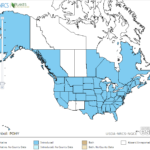Persicaria hydropiper (Polygonum hydropiper)
Non-Native
USDA, NRCS. 2018. The PLANTS Database (http://plants.usda.gov, 28 March 2018). National Plant Data Team, Greensboro, NC 27401-4901 USA.
Illustration: USDA-NRCS PLANTS Database / Britton, N.L., and A. Brown. 1913. An illustrated flora of the northern United States, Canada and the British Possessions. 3 vols. Charles Scribner’s Sons, New York. Vol. 1: 670.
What is Marshpepper Smartweed?
Physical Characteristics
Leaves:
- Sword-shaped
- 1.19-6.3 inches long
- 0.20-0.78 inches wide
Flowers:
- Many clusters
- Drooping
- Green or greenish white with pink at the tips
Fruit:
- One seeded
- Does not open to release fruit when ripe
- Dark brown or blackish in color
- Dull
- 0.08-0.13 inches long
Stem:
- Growing upward
- Fleshy
- 0.25-3.25 feet high
Where Does it Grow?
Non-Native
Marshpepper smartweed is non-native to North America, and it should not be promoted. This plant can be found in wet meadows and streams.
Pros and Cons of Marshpepper Smartweed
This plant is not native to North America, but has naturalized in much of the United States. While it is not illegal to possess this plant in Texas, it should not be introduced into new water bodies and should be treated with herbicide when present.


